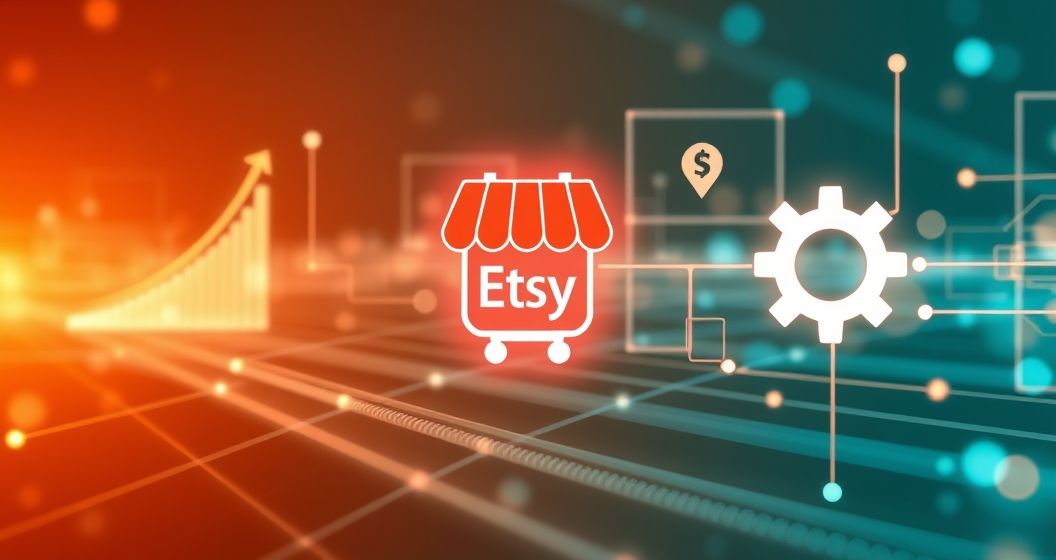For many artisans and creators, Etsy provides an unparalleled platform to showcase unique products to a global audience. As an Etsy shop grows, managing orders, inventory, shipping, and marketing can become increasingly complex. This is where strategic Etsy integrations become invaluable. By connecting your Etsy store with other specialized tools and platforms, sellers can automate tedious tasks, enhance operational efficiency, expand their market reach, and ultimately free up more time for creation. This guide explores the diverse world of Etsy integrations, detailing their benefits and helping you identify the right solutions to propel your business forward.
Understanding Etsy Integrations: Tools for Growth
Etsy integrations refer to the process of linking your Etsy shop to external software, applications, or platforms. These connections enable data to flow seamlessly between Etsy and other systems, creating a more cohesive and automated operational environment. Instead of manually transferring information between different tools, integrations handle this process automatically. This allows sellers to leverage powerful functionalities that Etsy’s native platform might not offer, from advanced inventory management to comprehensive accounting and multi-channel selling capabilities. Understanding these tools is crucial for any Etsy seller aiming for scalability and long-term success.
The Benefits of Integrating Your Etsy Store
Integrating your Etsy shop with third-party tools offers a multitude of advantages that can significantly transform your business operations. These benefits extend across various aspects of your selling journey, from the moment an order is placed to the final delivery and beyond. Embracing integrations allows sellers to work smarter, not just harder, leading to improved customer satisfaction and increased profitability.
Enhancing Operational Efficiency
One of the primary advantages of integrations is the ability to automate repetitive tasks. This includes automating order processing, updating inventory levels across multiple platforms, and generating shipping labels. By reducing manual data entry and administrative overhead, sellers can save countless hours each week. This newfound efficiency allows you to dedicate more time to product development, marketing, or simply enjoying a better work-life balance.
Expanding Your Sales Channels
While Etsy is a fantastic marketplace, many sellers choose to diversify their sales channels. Integrating Etsy with other e-commerce platforms like Shopify or WooCommerce allows you to manage your product listings and inventory from a centralized location. This enables you to reach a broader customer base beyond Etsy’s ecosystem, potentially increasing sales volume and reducing reliance on a single platform for your revenue.
Streamlining Inventory Management
Managing inventory can be a significant challenge, especially for shops with a diverse product range or those selling across multiple platforms. Integrations provide a centralized system to track stock levels, synchronize inventory updates, and prevent overselling. This ensures that customers always see accurate product availability, minimizing frustrating situations where an item is purchased but out of stock, thus enhancing customer trust.
Simplifying Shipping and Fulfillment
Shipping is a critical component of any e-commerce business. Integrations with shipping solutions can automate label creation, compare carrier rates, track packages, and send automated shipping notifications to customers. This not only speeds up the fulfillment process but also reduces the likelihood of shipping errors, leading to a smoother experience for both you and your buyers. Some services offer discounted rates, improving your profitability.
Boosting Financial Tracking and Accounting
Keeping accurate financial records is essential for understanding your business’s health and for tax purposes. Integrating Etsy with accounting software streamlines this process by automatically importing sales data, expenses, and transaction fees. This provides a clear, real-time overview of your finances, simplifying bookkeeping and making tax season significantly less stressful for business owners.
Automating Marketing and Customer Relationship Management
Effective marketing and customer engagement are key to building a loyal customer base. Integrations with email marketing services or customer relationship management (CRM) tools allow you to automatically collect customer information, segment your audience, and launch targeted marketing campaigns. This helps nurture customer relationships, encourage repeat purchases, and promote new products more effectively.
Key Types of Etsy Integrations and Their Applications
The landscape of Etsy integrations is vast, covering almost every aspect of running an online business. Understanding the different categories of tools available can help you identify specific solutions that align with your unique operational needs and growth objectives. Each type serves a distinct purpose, contributing to a more efficient and profitable Etsy shop.
E-commerce Platform Integrations
For sellers looking to establish their own branded online store while still leveraging Etsy’s marketplace, integrating with platforms like Shopify, BigCommerce, or WooCommerce is highly beneficial. These integrations allow you to sync product listings, inventory, and orders between your Etsy shop and your standalone website. This creates a multi-channel selling strategy, expanding your reach without duplicating effort for each product update or sale.
Shipping and Fulfillment Solutions
Dedicated shipping integrations significantly streamline the fulfillment process. Services like ShipStation, Pirate Ship, or Stamps.com connect directly to your Etsy orders, allowing you to print labels, manage international customs forms, and track packages efficiently. Many of these platforms offer negotiated discounts on shipping rates, which can lead to considerable cost savings. For example, some may offer subscription tiers starting from $9/month, while others are pay-per-label.
Accounting and Bookkeeping Software
Integrating with accounting software such as QuickBooks, Xero, or FreshBooks transforms your financial management. These tools automatically pull sales data, fees, and expenses from your Etsy account, categorizing them for easy reconciliation. This eliminates manual data entry, provides accurate financial reports for tax purposes, and offers clear insights into your business’s profitability, helping you make informed financial decisions.
Print-on-Demand (POD) Services
For sellers offering custom designs or products without holding physical inventory, print-on-demand integrations are indispensable. Platforms like Printful or Printify connect your Etsy shop directly to their fulfillment services. When an order is placed, it’s automatically sent to the POD provider, who prints the product (e.g., t-shirts, mugs, wall art) and ships it directly to your customer. This model reduces upfront costs, minimizes inventory risk, and simplifies logistics, though per-item profit margins may be slightly lower.
Inventory Management Systems
While some e-commerce platforms offer basic inventory functions, dedicated inventory management systems (IMS) like Stitch Labs or Skubana provide more robust features for complex operations. These tools offer advanced tracking across multiple warehouses, supplier management, and forecasting capabilities. For Etsy sellers with a high volume of products or those selling through numerous channels, an IMS ensures precise stock control and prevents costly overselling situations.
Marketing Automation Tools
Connecting your Etsy shop to marketing automation platforms like Mailchimp or Klaviyo allows you to build sophisticated email campaigns. You can automatically segment customers based on their purchase history, send abandoned cart reminders, promote new collections, or offer exclusive discounts. These integrations help maintain ongoing engagement with your customer base, fostering loyalty and driving repeat business efficiently.
Choosing the Right Etsy Integration for Your Business
With a plethora of integration options available, selecting the right tools can seem daunting. The key is to approach this decision strategically, aligning your choices with your specific business needs, goals, and budget. A well-chosen integration should solve a genuine problem and contribute to your overall efficiency and growth.
Assessing Your Business Needs
Before exploring integrations, clearly identify the challenges you currently face or the areas where you want to improve. Are you spending too much time on manual shipping label creation? Is your inventory often out of sync? Do you struggle with financial tracking? Pinpointing these pain points will guide you toward solutions that directly address your most pressing operational requirements, ensuring the integration provides tangible value.
Evaluating Integration Compatibility and Reliability
Always verify that an integration is officially supported and has a reliable connection to Etsy’s API. Check user reviews and ratings to gauge other sellers’ experiences with the tool’s stability and functionality. A poorly integrated or buggy solution can create more problems than it solves, leading to data discrepancies and operational headaches. Prioritize solutions with a strong track record and clear compatibility.
Considering Cost vs. ROI
Integrations often come with a cost, whether it’s a one-time purchase or a recurring subscription fee. Evaluate whether the investment will yield a positive return on investment (ROI) through saved time, increased sales, reduced errors, or improved customer satisfaction. Some tools offer free trials, allowing you to test their value before committing financially. Consider both direct costs and the indirect benefits.
User-Friendliness and Support
Even the most powerful integration is ineffective if it’s too complicated to use or lacks adequate customer support. Look for tools with intuitive interfaces and clear documentation. Responsive customer support is also crucial, especially when setting up the integration or troubleshooting any issues that may arise. Ease of use ensures faster adoption and fewer disruptions to your daily workflow.
Maximizing Your Etsy Potential with Strategic Integrations
Etsy integrations offer a powerful pathway for sellers to move beyond manual processes and embrace a more automated, efficient, and scalable business model. By thoughtfully selecting and implementing the right tools for shipping, inventory, accounting, and marketing, you can transform your Etsy shop into a highly optimized operation. These strategic connections not only save valuable time but also enhance accuracy, expand your market reach, and ultimately contribute to a more profitable and sustainable creative business. Embrace the power of integration to unlock your shop’s full potential and focus more on what you love to do: creating unique, cherished items.






